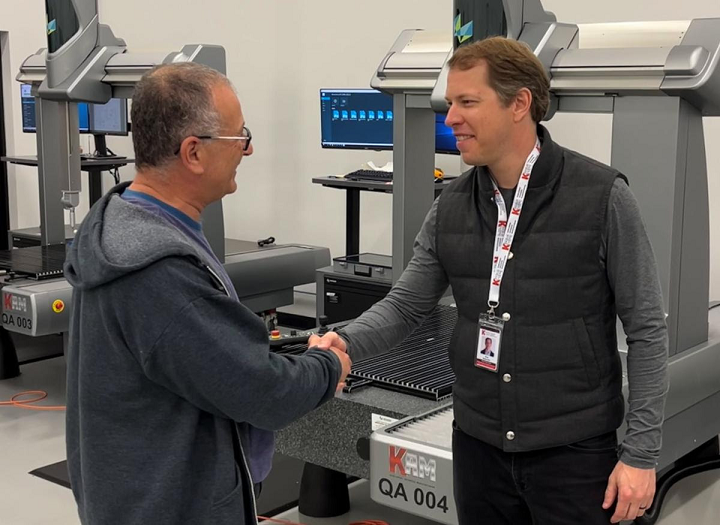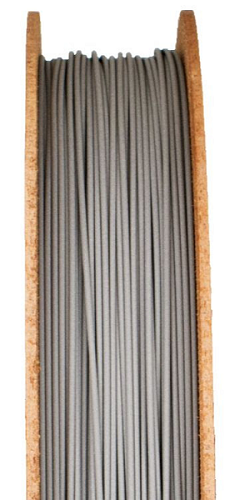RadTech has launched a new UV+EB sustainability website…this story kicks off today’s 3D Printing News Briefs, followed by metal 3D printing news, as Keselowski Advanced Manufacturing acquired a Sapphire XC from Velo3D, Virtual Foundry’s H13 Tool Steel Filamet is now available, and Farsoon’s 3D printed tantalum interspinal fusion cage has been NMPA-certified. Moving on, BOFA Americas will be showcasing its AM filtration and atmosphere management technology at RAPID. Finally, researchers in Australia are combatting coastal erosion with 3D printed lattice structures.
RadTech Launches New UV+EB Sustainability Website
Nonprofit trade association RadTech, The Association for UV+EB Technology, is dedicated to advancing UV (ultraviolet) and EB (electron beam) technologies, which are used in a multitude of applications, such as electronics, packaging, and 3D printing. The association acts as an international forum, as well as a source of information for those involved in using UV+EB technologies, and has just launched a new sustainability website that will focus on RadTech’s commitment to sustainability. This new site will provide information on several topics, such as updates on the organization’s sustainability research and projects, the UV+EB industry’s commitment to sustainability, articles and videos on related topics, and resources for members to use in their own sustainability efforts.
“We are excited to support our members with this new resource. Our goal is to make it easy for our members to learn about sustainability and to take steps to reduce their environmental impact,” said Cara Bommarito, Sustainability Manager at RadTech.
KAM Acquires Velo3D’s Sapphire XC Large-Format Metal 3D Printer

L-R: Velo3D CEO Benny Buller and Keselowski Advanced Manufacturing owner and founder Brad Keselowski in the company’s Statesville, NC facility.
In order to expand its 3D printing capabilities, Keselowski Advanced Manufacturing (KAM) has acquired a large-format metal Sapphire XC printer from Velo3D, and joined the Velo3D Contract Manufacturer Network. The printer is KAM’s first purchase from Velo3D, and is calibrated to print a nickel-based superalloy—commonly used in the space, aviation, defense, and energy applications in which KAM specializes—that offers both corrosion resistance and oxidation at high temperatures. The Sapphire XC can print parts up to 600 mm in diameter by 550 mm in height and can be easily upgraded to the larger Sapphire XC 1MZ; this choice of printer makes sense, then, as KAM purchased it in order to print much larger, high-quality parts for its customers.
“Our customers are some of the most innovative companies in their industries and, as a result, they present some of the most complex manufacturing problems to solve—this is where KAM thrives. We are continually investing in new technologies to provide the highest quality finished parts, which starts with additive manufacturing technology but also includes quality precision machining to a finished part,” explained Brad Keselowski, Owner and Founder of Keselowski Advanced Manufacturing. “With our established processes and team, we feel confident that our Sapphire XC will allow us to serve new industries by increasing the physical size of the parts we can deliver. This will be our first Sapphire XC but as demand for these parts increases, we can easily add more printers to our fleet due to Velo3D’s machine-to-machine repeatability.”
FFF 3D Printable H13 Tool Steel Filamet Available
The Virtual Foundry creates a special type of metal filament, called Filamet, by mixing a binder with metal powder and extruding the mixture into a spool of filament. Its latest offering is H13 Tool Steel, used for high-strength and wear-resistant parts and available in 0.5 kg and 1 kg units, with 1.75 mm and 2.85 mm diameters. The material can be used on FFF 3D printers that accept any brand of filament, such as Raise3D, Creality, Prusa, and gMax. No Filawarmer is needed, though a 0.6 mm hardened steel nozzle is needed, and the suggested printing temperature is 215°C, with a suggested flow rate of 135%, though both of these can be adjusted as necessary. The Virtual Foundry would like to thank Partner Innovator Drew Turner for “preparing an initial debind and sinter schedule for Tool Steel H13 Filamet!”
“Think about it – What could you do with H13 Tool Steel that you 3D print on your standard FFF 3D printer and debind & sinter in your standard kiln?
“Now is the time to find out!”
3D Printed Tantalum Interspinal Fusion Cage NMPA-Certified

Tantalum interspinal fusion cage with porous structures designed for 3D printing (image courtesy Huaxiang Group)
Chinese medical 3D printing solutions provider Huaxiang Group announced that its tantalum interspinal fusion cage, 3D printed on a Farsoon Technologies metal powder bed fusion (PBF) system, has received category 3 medical device clearance from NMPA (National Medical Products Administration), and that it’s actually China’s first NMPA-certified tantalum orthopedic implant made with metal PBF 3D printing. Tantalum is great for medical implants, due to its stable chemical properties, excellent biological inertness and compatibility, and abrasion resistance, but it’s also difficult to process, because of high density (16.6 g/cm3), an extremely high melting point (over 3,000°C), and elastic modulus (185.7 GPa). But with application development of orthopedic products like joint prosthetics, femoral head repair, and cranial implants with this material, which encourages bone and vascular tissue growth and reduces stress, the market has continued to push to innovate its manufacturability.
Farsoon and the Huaxiang Group have many joint achievements in AM medical applications, including over 14,000 customized surgical guide cases by the end of January 2023. In this case, the Farsoon-3D printed tantalum porous interspinal fusion cage solutions developed by Huaxiang have several unique advantages, starting with reduced cost and part lead time and improved efficiency with an optimized manufacturing workflow. These 3D printed implants have excellent load-bearing capability, fatigue resistance, and stability, reduced stress-shielding, and can be fully customized and produced according to specific patients and their conditions. Its trabecular micro structure can achieve a high porosity of 68-78% to promote bone tissue and vessel fusion, and the elastic modulus is comparable to human trabecular and canellus bone. To see this 3D printed tantalum porous interspinal fusion cage product for yourself, visit Farsoon at Booth #2224 at the upcoming RAPID + TCT in Chicago.
BOFA Americas Showcasing Filtration Technology & More at RAPID 2023
Speaking of RAPID, BOFA Americas will be taking advantage of the show floor in Chicago May 2-4 to showcase its 3D printing filtration and atmosphere management technology. The industrial filtration leader, which was launched as BOFA International in 1987 and acquired by US-based Donaldson Company, Inc. in 2018, will be exhibiting a wide range of products at McCormick Place, including its AM 400, which uses patented technology for safe onsite exchange of filters that remove harmful gases and particulate from metal AM processes, and 3D PrintPRO HT, which filters out high-temperature gases and particulates and adds airflow innovations to help maintain optimal conditions. Additionally, BOFA Americas will showcase its AD Oracle SA iQ for large-scale 3D printing methods, like binder jetting and SLM, and the 3DPrintPRO 2 for small-format, open 3D printers; 3DPrintPRO 3 for enclosed or partially enclosed printers; and 3DPrintPRO 4, which supports FFF, SLA, DLP, and material jetting processes.
“We look forward to this event each year where we are able to display the developments and innovations in filtration that keep pace with advances in the wider additive manufacturing environment. As a result, we remain at the forefront of emissions filtration, temperature control and airflow management which help manufacturers optimize product quality and the efficiency of operations,” said Katrina Clemens, General Manager, BOFA Americas, Inc.
Researchers Combatting Coastal Erosion with 3D Printing
A team of scientists from Deakin University in Australia are fighting against coastal erosion, and supporting the growth of wetland species, using 3D printed biodegradable lattice structures. The researchers, from the university’s Blue Carbon Lab, are working in Port Phillip Bay and Western Port Bay, planting mangrove seeds into lattice frames that are 3D printed out of potato starch from industrial waste. If the structures are successful, they could help serve as flood defenses, as well as support biodiversity and protect coastlines from erosion. The researchers will be examining the different factors that promote regeneration, like water conditions, soil type, and root systems, while citizen scientists will track the growth and survival rates of the seeds. These lattices have less of an environmental impact than restoration projects that use concrete or plastic structures, as they decompose in less than ten years, and during their lifespan they encourage soil accumulation, slow the flow of water, and help mangroves establish roots, particularly in areas already prone to erosion.
Stacey Trevathan-Tackett of Deakin University said, “Sometimes when you remove [the supporting structures] they might disturb the plants themselves.
“They’re there for a while to help stabilize the sediment, stabilize the roots, let the plants grow, and then eventually they’ll degrade themselves.”
Subscribe to Our Email Newsletter
Stay up-to-date on all the latest news from the 3D printing industry and receive information and offers from third party vendors.
You May Also Like
3D Printing Unpeeled: New Arkema Material for HP, Saddle and Macro MEMS
A new Arkema material for MJF is said to reduce costs per part by up to 25% and have an 85% reusability ratio. HP 3D HR PA 12 S has been...
3D Printing News Briefs, January 20, 2024: FDM, LPBF, Underwater 3D Printer, Racing, & More
We’re starting off with a process certification in today’s 3D Printing News Briefs, and then moving on to research about solute trapping, laser powder bed fusion, and then moving on...
3D Printing Webinar and Event Roundup: December 3, 2023
We’ve got plenty of events and webinars coming up for you this week! Quickparts is having a Manufacturing Roadshow, America Makes is holding a Member Town Hall, Stratafest makes two...
Formnext 2023 Day Three: Slam Dunk
I’m high—high on trade show. I’ve met numerous new faces and reconnected with old friends, creating an absolutely wonderful atmosphere. The excitement is palpable over several emerging developments. The high...



































